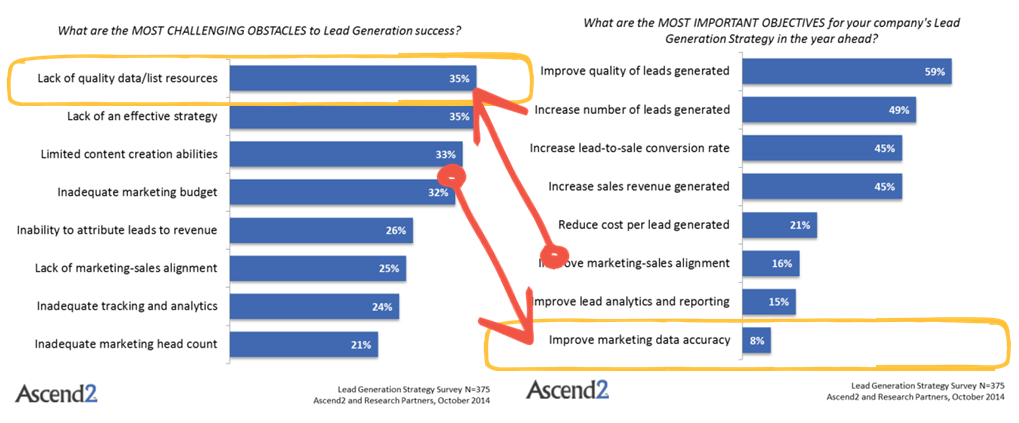Data quality is a term that marketers are using more often – if they’re smart. Data science is evolving, which is good for marketers who recognize the need to verify their contact lists. This is how they pass along quality leads to their sales teams and see the best results from their content marketing.
Though they know clean marketing databases are key to better marketing results, few companies make it a priority. Why?
Because it’s hard work, and there’s still a large database knowledge gap on many creative teams. Unless you’re an expert in database marketing, you may not know how to go about cleaning out bad contact information, even if you’re willing to roll up your sleeves and do the hard work.
Almost 35 percent of marketers said they have bad data quality, according to Ascend2’s Lead Generation Strategy Summary Report, but only 8 percent have plans to improve it.
The high cost of bad data
Your marketing and sales processes will be more streamlined (and successful) if you confirm the information you’ve gathered is accurate before passing it along as a sales qualified lead. Just to give you an idea of the data you should be verifying:
-
Contact names
-
Job titles
-
Email addresses
-
Business websites
-
Industry
Data quality issues don’t just arise at the point of entry. It’s not necessarily that the person or service you’ve tasked with building your marketing database is unreliable – it’s often that information can grow stale. People leave jobs, change their phone numbers and move offices. And like stale cereal, it doesn’t taste good and it doesn’t fill you up.
An outdated or inaccurate lead is a waste of time and resources. If you pass bad contact information to your sales team, it will only cause bottlenecks.They’ll have to backtrack and do additional research to find right data before they can take any sort of action – and this could possibly impact how the marketing team is valued as a contributor to new business.
Bad contact information will also hurt your email marketing efforts and paint an inaccurate picture about your buyer personas. Sending messages to outdated email addresses can trigger a lot of kickbacks, which Google might flag (and put your business on a no-send list). It can also destroy persona-based nurture campaigns. Incorrect information about contacts might lead you believe you’re primarily targeting decision makers or a subset of users with a specific pain point, when the people who read your brand content are actually the people doing research on behalf of decision makers or find the message otherwise irrelevant.
You’re less likely to earn sales-ready leads in the first place, if you send content that’s not appetizing to the actual (versus perceived) audience.
If you know you know you have expired information in your contact data, or you just want to do some upkeep to make sure your information is accurate, I recommend a data cleanse.
How to clean your database
The first step is to segment out the good data from the bad data by confirming that it’s correct. Businesses should run a check at least every six months to update information.
There are two ways to do this:
- Manually check the information – call the phone numbers, verify job titles, visit websites, etc. This cost is human capital, and the risk is human error.
- Run a program – there are some technology programs that verify contact information. This involves an upfront investment, but it’s faster… with the risk of mechanical error.
Waste not, want not marketing: Once you’ve identified your ‘problem accounts’ that contain inaccurate information, segment these contacts according to the issues. Create a list of leads that have incorrect email addresses, and another list where you have the wrong phone number on file. This makes it easy to target areas where new info is needed instead of tossing lists that could hold value. Even if a contact left the business, you might be able to add a new contact – so don’t immediately discount this opportunity.
You want to make sure your data cleanse system is organized so you update the necessary accounts without impacting clean ones. There are some tools and systems that that can help with this:
-
Insertion programs allow you to sync info if the account already exists
-
Demand tools merge duplicates, mixing and matching the information you want to keep and standardizing all the data across
It’s critical that you address problematic accounts and cleanse out bad information, but you don’t want to neglect the good data – you want to add even more value to keep it from going stale.
Don’t ignore the good data
If you only address the bad contacts, you’ll constantly be playing a game of catch up.
An effective database isn’t merely a game of addition and cleanup; it’s also dependent on keeping up with your good information and adding new insights whenever possible.
An effective database isn’t a game of addition and cleanup; it’s dependent on good information & new insights.
We’re constantly enriching that data over time, continually adding value and confirming that all the information we have on file is accurate. My team reconfirms all data at least twice a year, to take necessary cleanup steps and enhancing the accurate information with more details when possible.
Additionally, if you use certain automation programs, you can set up alerts to keep on top of things – like duplicate accounts, or neglected leads. Depending on the system you use, you can also monitor, from a high-level, what works. If you notice your information is decaying at a faster rate, you modify the strategy to reconfirm more often.
 Build a strong foundation to become a smarter marketer
Build a strong foundation to become a smarter marketer
Data is important to your marketing and sales efforts. Your conversions depend on it.
A clean database allows you to accurately splice and dice your contact lists for content nurture campaigns that can significantly enhance what your marketing team brings to the revenue table. If you see that people with a specific job title turn into sales opportunities more often, you can prioritize these users in nurture campaigns, and content efforts at large, with the understanding that they’re more valuable for your business.
As you work to clean your database and improve the quality of your contact information, conversion rates will also increase. What that means is your email campaigns will be more effective, your leads will get nurtured with the right information and your sales team will have quality contacts who are ready to learn more about your business.






